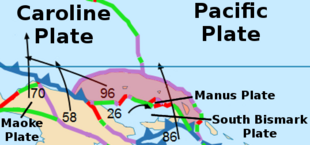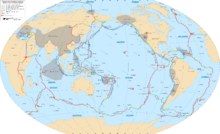Earth:North Bismarck Plate
| North Bismarck Plate | |
|---|---|
 | |
| Type | Minor |
| Movement1 | north-west |
| Speed1 | nil independent of Pacific Plate which has 96 mm/year |
| Features | Pacific Ocean |
| 1Relative to the African Plate | |
The North Bismarck Plate is a small tectonic plate located in the Bismarck Sea off the northeast coast of New Guinea. It is currently regarded as a relic or inactive plate by most.[3][2] At one time it was called the Manus Plate, but this term was later used for a modelled microplate at the south east boundary of the North Bismarck Plate.[4]:22
Tectonics
The plate contains most of the Melanesian arc volcanoes, related to current and historic arc volcanism, except those of New Britain which are on the active South Bismarck Plate.[2]
To the north it has collided with the Pacific Plate and the Caroline Plate, part of the western part is subducting under other active plates in New Guinea, and it is separated from the South Bismarck Plate by a divergent boundary called the Bismarck Seismic Sea Lineation (BSSL).[5] The BSSL is a very seismically active area but the assigned shallow earthquakes tend to be less than magnitude 7.[6] The plate is moving westerly along with the Pacific Plate.[2] Between the plate and the Caroline Plate is the West Melanesian Trench and between the plate and the Pacific plate is the Kilinailau Trench.[2] Neither trench has good evidence for current subduction activity but were certainly historically active.[2]:68 There are a few shallow low intensity earthquakes to the south/south west of these trenches on a line of the old arc that extends from the smaller northern Admiralty Islands in the west through to Mussau Island and beyond.[7]
See also
- List of earthquakes in Papua New Guinea
References
- ↑ Bird, P. (2003). "An updated digital model of plate boundaries". Geochemistry, Geophysics, Geosystems 4 (3): 1027. doi:10.1029/2001GC000252. Bibcode: 2003GGG.....4.1027B. http://peterbird.name/publications/2003_PB2002/2003_PB2002.htm.
- ↑ 2.0 2.1 2.2 2.3 2.4 2.5 Holm, RJ; Rosenbaum, G; Richards, SW (1 May 2016). "Post 8 Ma reconstruction of Papua New Guinea and Solomon Islands: Microplate tectonics in a convergent plate boundary setting". Earth-Science Reviews 156: 66-81. doi:10.1016/j.earscirev.2016.03.005.
- ↑ Weiler, PD; Coe, RS (2000). "Rotations in the actively colliding Finisterre Arc Terrane: paleomagnetic constraints on Plio-Pleistocene evolution of the South Bismarck microplate, northeastern Papua New Guinea". Tectonophysics 316 (3-4): 297-325. doi:10.1016/S0040-1951(99)00259-0.
- ↑ Bird, P. (2003). "An updated digital model of plate boundaries". Geochemistry, Geophysics, Geosystems 4 (3): 1027. doi:10.1029/2001GC000252. Bibcode: 2003GGG.....4.1027B. http://peterbird.name/publications/2003_PB2002/2003_PB2002.htm.
- ↑ Holm, RJ; Richards, SW (2013). "A re-evaluation of arc–continent collision and along-arc variation in the Bismarck Sea region, Papua New Guinea". Australian Journal of Earth Sciences 60 (5): 605-19. doi:10.1080/08120099.2013.824505. https://citeseerx.ist.psu.edu/document?repid=rep1&type=pdf&doi=34986567faf3d0b680ff2c5ada5000fbf9fa1f7b.
- ↑ Yang, Guangliang; Shen, Chongyang; Wang, Jiapei; Xuan, Songbai; Wu, Guiju; Tan, Hongbo (2018). "Isostatic anomaly characteristics and tectonism of the New Britain Trench and neighboring Papua New Guinea". Geodesy and Geodynamics 9 (5): 404-410. doi:10.1016/j.geog.2018.04.006. ISSN 1674-9847. https://www.sciencedirect.com/science/article/pii/S1674984717301738.
- ↑ "USGS: Regional Information Admiralty Islands region, Papua New Guinea". https://earthquake.usgs.gov/earthquakes/eventpage/us6000kzm4/region-info.
 |


